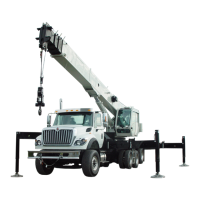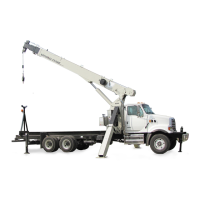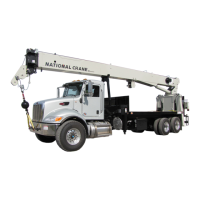SAFETY PRECAUTION - AERIAL LIFT NBT40-1 SERIES OPERATOR MANUAL
3-14
3-29-2018 Control # 610-00
Sparks from the aerial lift’s electrical system and/or engine
exhaust can cause an explosion. Do not operate this aerial
lift in an area with flammable dust or vapors, unless good
ventilation has removed the hazard.
Carbon monoxide fumes from the engine exhaust can cause
suffocation in an enclosed area. Good ventilation is very
important when operating the aerial lift.
Before actuating swing or any other aerial lift function, sound
the horn and verify that all personnel are clear of rotating and
moving parts.
Never operate the aerial lift when darkness, fog, or other
visibility restrictions make operation unsafe. Never operate
aerial lift in thunderstorms or high winds.
Always be aware of your working environment during
operation of the aerial lift. Avoid contacting any part of the
aerial lift with external objects.
Clear all personnel from the counterweight and
superstructure area before removing the counterweight (if so
equipped).
Keep unauthorized personnel clear of the working area
during operation.
You must always be aware of everything around the aerial lift
while lifting or traveling. If you are unable to clearly see in the
direction of motion, you must post a look out or signal person
before moving the aerial lift. Sound the horn to warn
personnel of impending movement.
Only operate the aerial lift by using the designated operator’s
station controls. Do not reach over lift platform rails to
operate any controls.
Operate the aerial lift slowly and cautiously, looking carefully
in the direction of movement.
Become familiar with all factors peculiar to the job site before
making a lift. Look before swinging your aerial lift. Even
though the original setup may have been checked, situations
do change.
Never push or pull loads with the aerial lift's boom; never
drag a load.
If the boom should contact an object, stop immediately and
inspect the boom. Remove the aerial lift from service if the
boom is damaged.
Be sure everyone is clear of the aerial lift and work area
before commencing operation.
Refuse to use any poorly maintained or damaged
equipment:
• The aerial lift should be left in the smallest, most stable,
valid operational configuration that the job site
practically allows.
• The aerial lift can not be left running, or in erection mode,
or in wind conditions in excess of allowed values.
• The boom should be retracted as far as is practical, the
aerial lift configured in as stable a configuration as
possible (boom angle, superstructure orientation, boom
extension angle, etc.)
• In high winds the boom and boom extensions should be
lowered, or secured. Changing weather conditions
including but not limited to: wind, ice accumulation,
precipitation, flooding, lightning, etc. should be
considered when determining the location and
configuration of an aerial lift when it is to be left
unattended.
Emergency Lowering Procedure
The Emergency Lowering System may be used to move the
aerial lift platform to a safe configuration in the event of an
emergency situation if the platform is disabled in an
extended configuration. The system can be controlled from
(2) different locations. A ground operated control is located
on the torsion box under fender decking near right side
outrigger control station. There is also an enable button in
the aerial work platform controller which may be used to
activate this system. See “Emergency Lowering Procedure”
5-8.
DANGER
Aerial Lift Hazard!
To avoid death or serious injury, never lift a load with hoist
line while operating aerial lift. All hoist lines should be
removed or properly stowed before operating aerial lift.
